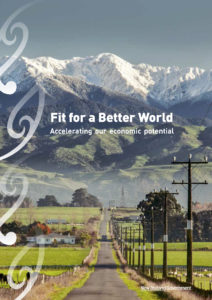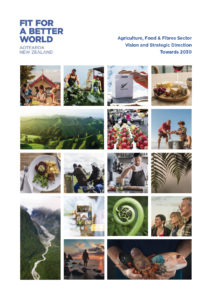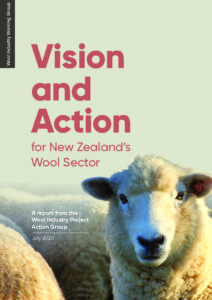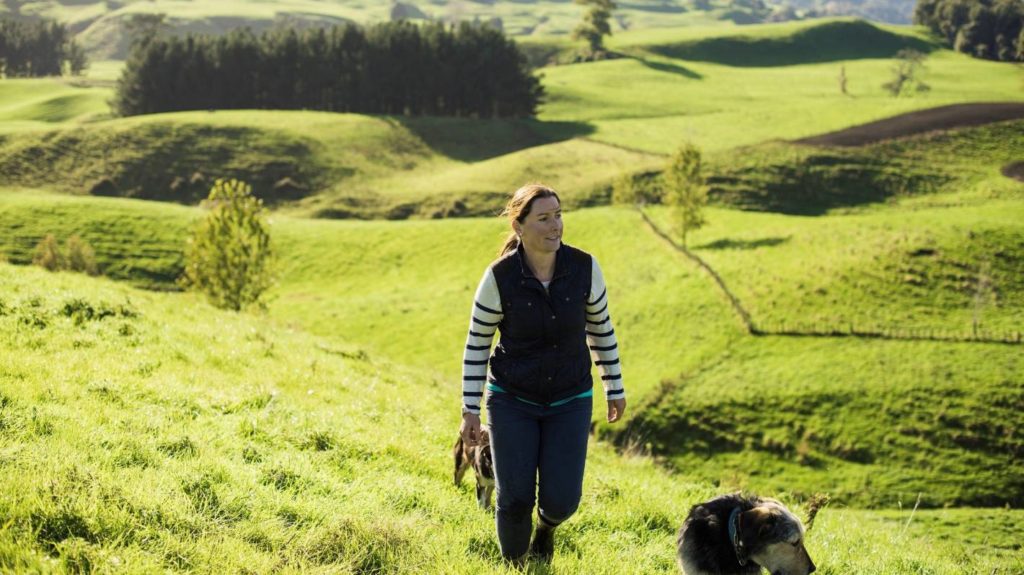Jacinda Ardern sounded encouragingly positive about the primary sector and its prospects when she and Agriculture Minister Damien O’Connor recently launched the 10-year primary sector plan (somewhat clumsily called Fit for a Better World – Accelerating our Economic Potential). The contribution scientists can make is recognised in the report, which says critical contributors can be made to the creation of value through new product development and process innovations.
It says: “We will work to align our research and science settings to lift productivity, sustainability and value across the sector and speed up commercialising innovation. We will also address barriers to innovation, and drive the use of science and the food safety system to support increased value, including development of health and provenance claims in existing and new products.”
 The Fit for a Better World Action Plan is based on three themes:
The Fit for a Better World Action Plan is based on three themes:
• Productivity: adding an additional $44 billion in export earnings over the next decade through a focus on creating value.
• Sustainability: reducing our biogenic methane emissions to 24-47% below 2017 levels by 2050; and 10% below by 2030. Plus restoring New Zealand’s freshwater environments to a healthy state within a generation.
• Inclusiveness: employing 10% more New Zealanders from all walks of life in the food and fibre sector by 2030, and 10,000 more New Zealanders in the primary sector workforce over the next four years.
Ms Ardern described the primary sector as “a huge part of our economy and our brand” and credited it with making significant strides to improve the sustainability of our products and practices.
“Fit for a Better World builds on that, and the potential that exists for us to go even further,” she said.
The Government is already backing parts of the plan – described as a 10-year roadmap – with more than $1.5 billion invested in freshwater quality, water storage, supporting exporters, reducing agriculture emissions, assisting farmer catchment groups, the One Billion Trees scheme, getting people into sector jobs, rural sector resilience and developing new high-value crops.
But the NZIAHS emphasises the importance of ensuring the money gets through to the people doing the hard yards on the ground (or in the streams).
And I am hoping, of course, that the agscience sector gets a fair slice of the action and benefits from the redirection of the funding involved in this strategy. I note the Government is bringing forward $84 million to upscale Sustainable Food & Fibre Futures (SFF Futures) to further boost innovation. This is on top of the $70 million available for the next two years.
SFF Futures supports problem-solving and innovation in New Zealand’s food and fibre sectors by co-investing in initiatives that make a positive and lasting difference, from small grassroots community projects to large-scale industry development.
Then there’s the sum of $122 million to support farmer-led solutions as part of the Government’s $229 million investment in Productive and Sustainable Land Use.
Moreover Budget 2020 provided $5.4 million for critical resources to identify and manage animal welfare issues and $45.3 million to fund the secure containment of new imported plant varieties and breeding material that requires testing for pests, and to enable the introduction of imported plant material for the horticulture sector to develop new and innovative high-value crops and cultivars.
 The Government reminds us, too, that significant investment has been allocated from the Provincial Growth Fund for water storage initiatives, at $134 million over the last two years, and in fencing waterways, water reticulation and riparian management, at $100 million.
The Government reminds us, too, that significant investment has been allocated from the Provincial Growth Fund for water storage initiatives, at $134 million over the last two years, and in fencing waterways, water reticulation and riparian management, at $100 million.
Agriculture Minister Damien O’Connor said the sector’s ability to record 4.5% growth to about $48 billion of exports in the past year despite COVID-19, highlighted demand for our top-quality products.
He referenced the Primary Sector Council’s Vision and Strategic Outline, released at the same time, and said “we need to act quickly and boldly and can’t continue to rely on volume growth to generate greater returns”.
We ag scientists are ready to do our bit, Minister.
Revitalising wool
Hard on the heels of the Fit for a Better World Action Plan, the Government released a report (yes, another one) aimed at making the strong wool sector more sustainable and profitable.
This report, Vision and Action for New Zealand’s Wool Sector, was developed by the Wool Industry Project Action Group and sets out three recommendations to help the strong wool sector grow and thrive:
• Develop a market-focused investment case and strategic roadmap for the strong wool sector;
• Establish the capability necessary to get the sector match fit and ready for the opportunities ahead;
• Establish a governance and coordination capability.
I would like to think there will be a role for good research in these plans and note that the wool sector is intended to benefit from some of the $84 million of SFF Futures funding brought forward for innovative and creative projects, to support delivery of the Fit for a Better World roadmap. My optimism is reinforced by the Agriculture Minister Damien O’Connor, who said he expects many innovative wool projects can benefit from this increase in available funding.
He proceeded to announce SFF Futures support for Woolchemy NZ Limited, an innovative New Zealand company that aims to transform wool into something more valuable, using sustainable, environmental and ethical processes.Woolchemy will receive almost $80,000 to investigate a sustainable, intelligent non-woven textile that incorporates New Zealand strong wool for use in nappies.
Businesses like AgWool are reimagining the traditional strong wool supply chain, and organisations like Lanaco and the Wool Research Organisation of New Zealand are innovating to find new and high-value uses for strong wool, the Minister said.
You can read the Action Group’s full report and learn more about getting involved here.
Terrific tree-planting idea
 I was heartened to learn about King Country farmer Dani Darke’s invitation to big businesses to use her land for carbon offset tree planting in an arrangement aimed at benefiting both the business and agricultural sectors.
I was heartened to learn about King Country farmer Dani Darke’s invitation to big businesses to use her land for carbon offset tree planting in an arrangement aimed at benefiting both the business and agricultural sectors.
Ms Darke used social media to offer up 10 hectares of her land to plant native trees, hoping to attract the interest of Air New Zealand, Genesis Energy, Contact Energy, Z Energy, and anyone else who wanted to participate. Under her proposal, the companies would pay for the fencing and planting and collect the credits to offset their emissions. Ms Darke would retain the land ownership and determine which trees are planted in the right place.
Air New Zealand last year became involved in a limited liability partnership with Contact Energy, Genesis Energy and Z Energy to form Dryland Carbon LLP, enabling
the four companies to invest in the establishment of a geographically diversified forest portfolio to sequester carbon. The goal is to produce a stable supply of forestry-generated NZU carbon credits to allow the partners to meet their annual requirements under the ETS.
Ms Darke’s idea was sparked by a concern for communities such as hers, in Aria, if big business buys swathes of land for blanket planting of pines to secure carbon credits under the ETS. On her own sheep and beef farm, there is a special biodiversity in the area she would like to protect – native bats, fresh water mussels and freshwater crayfish.
Federated Farmers president Andrew Hoggard has said he thinks Ms Darke’s idea is better than the blanket planting of pine trees. “If you amalgamate what could be done across New Zealand farmland, it equates to quite a bit”, he told Stuff
Mr Hoggard acknowledges that large companies probably don’t want to deal with hundreds or thousands of farms and their owners, but he sees a role for Federated Farmers as an intermediary. It’s certainly something he wants the Feds to explore.
I wish him and Ms Darke well in promoting this scheme. Not only would it provide carbon offsets for polluting industries, but it would benefit the farmers with fencing, pest control and so on, and help the environment through biodiversity and nutrient management.
This makes it a win-win-win arrangement that doesn’t involve blanket planting of Pinus radiata, doesn’t lead to rich carbon polluters buying up good farms to assuage their guilt or whatever, and doesn’t destroy rural communities
 |
Newsletter from Prof Jon Hickford NZIAHS President |
| The NZIAHS Canterbury Section committee are pleased to announce that registrations are open for our Gene Editing Forum to be held on Wednesday 21st October 2020 from 9.00am to 3.30pm in Stewart 1 at Lincoln University.The topic of the forum ‘Gene Editing’ has been chosen because the report from the Royal Society Expert Panel on Gene Editing recommended that there was an ‘urgent need for wide and well-informed discussion and debate about gene editing’. Since the release of that report, the issue seems to have ‘gone quiet’, and there appears to be very little indication of where we might go from here. At NZIAHS, we are looking to take the next step. How might we start to think about the use of this technology in the future?Link to programme and registration form https://agscience.org.nz/canterbury-forum/ |













